by Nick Edwards | The Ionian Islands or Ionia nisia are many smaller islands as well as the seven principal ones in Greece traditionally called the Heptanese. Zakynthos (also spelled Zakinthos) or Zante is the third largest of those group of Islands often called an Archipelago, covering an area of about 406 square km (157 square mi) and a coastline of roughly 123 km (76 mi) in length. Zakynthos is unique in that it has beautiful rich flora and fauna characteristic of all the Ionian islands, hence the name the island that has it all. The principal agricultural products are olive oil, currants, grapes and citrus fruit. History shows that Zante is the target of conquerors over the years because of it’s beautiful flora and fauna and remarkable location for supplies during war time. The Venetians called Zante “Fior Di Levante,” meaning the Flower of the East. Its strong history and influences by many cultures make it the jewel of their empire.
As you get to the island from the air, you can see it is clearly divided into four separate areas: the busy industrial capital Zakynthos; the fun beaches to the south and east; the beautiful flora and fauna of the central plain; and the tall beautiful mountains of the north and west. Since the mid 1980s, Zakynthos has become a Mediterranean must see for 18–30 year old tourists seeking out the clubbing hotels, nightclubs, bars and restaurants. This is where the visitors culminate to swim its endless beaches in Lagana, Tsilivi, Argassi, Kalamaki, Alykes during the day and watch the sunset from the cliffs of Keri and Kryoneri, listen to the islanders sing their cantatas and see the endangered Caretta caretta sea turtles lay their eggs in the island’s white sands. The Bay of Laganas is the site of the first National Marine Park and the prime nesting area for loggerhead sea turtles (Caretta caretta) in the Mediterranean.
My first visit to Zakynthos in 1984 was not my own doing at all. I was teaching English in Athens and an old school friend who was doing nicely in business sent me a plane ticket to join him and his wife in the then fledgeling resort of Laganas for a couple of nights. The current excesses of the resort were not in evidence but I do recall my surprise when the horiatiki salad came without any olive oil on it and it was an equal shock to the waiter when I pithily enquired in Greek as to where the dressing was. Yet when Pete rented a car and we headed for the hills I could sense there was more to the island than met the eye.
It was a baker’s dozen years till my duties for the Rough Guide took me on a second visit and have kept me coming back ever since. As I have got to know Zakynthos more intimately that initial impression of its schizophrenic nature have simply been confirmed. Cloyingly touristic in parts and surprisingly wild in others, it’s not to everybody’s liking but tends to grow on you with successive visits. The island divides itself quite neatly into four separate entities: the busy working capital of Zakynthos Town; the bustling commercial beach areas of the south and east coasts; the peaceful and fertile central plain; and the ruggedly imposing mountains of the north and west.

Dionysios Solomos, Greek PoetAs is the case in the rest of the Ionian archipelago, Zakynthos has quite a reputation in the arts, especially literature. Dionysios Solomos (1798-1857), its most famous man of words, penned the poem that became the national anthem of Greece, Hymn To Liberty, and was a great champion of demotic Greek. The other noted poet to hail from the island was Andreas Kalvos (1792-1869), who preferred the purist katharevousa form of the language for his twenty Odes. Playwright and novelist Grigoris Xenopoulos (1867-1951) was the third literary star to rise here, his novel Red Rock being the most revered of his works. He was also the founder and editor of the Nea Estia magazine, which is still published. He became a member of the Academy of Athens in 1931, and founded the Society of Greek Writers (Εταιρεία Ελλήνων Λογοτεχνών) together with Kostis Palamas, Angelos Sikelianos and Nikos Kazantzakis.
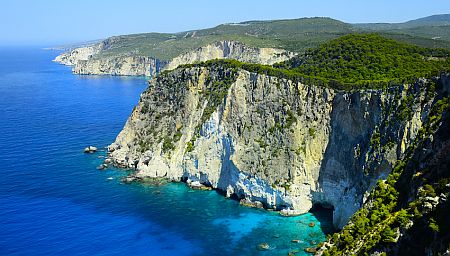
The island was originally settled by Achaeans from the mainland in prehistory and earned a brief mention in Homer’s Odyssey as “wooded Zakynthos”, an apt description still today, as it shares the common Ionian characteristic of greenery. In ancient times it was ruled by whoever held the upper hand in Greece itself, from the Athenians and Spartans through the Macedonians and Romans to the Byzantine Empire. Subsequently, along with the rest of the Ionians, its history diverged from the rest of Greece, first being handed round a succession of Italian rulers before the Venetians saved the region from the lengthy Turkish occupation suffered by the rest of the country and established a dynasty on Zakynthos from 1485. The names of the governing nobility were recorded in the legendary Libro d’Oro, hated by the impoverished locals and eventually incinerated when the French took over in 1797. Following a brief spell under a Turko-Russian alliance and the French again, Zakynthos spent its last fifty-five years under colonial rule as a British protectorate before being reunified with Greece in 1864.
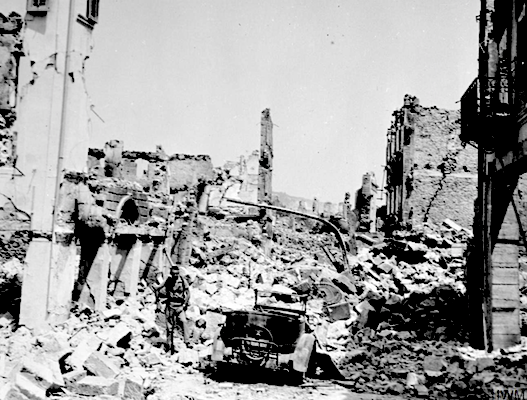
The most notable and devastating event in the island’s modern history was the 7.2 Richter earthquake that decimated both it and neighbouring Kefalonia in August 1953. Over seventy percent of dwellings were destroyed in the quake and ensuing fires, which raged for ten days. Mercifully, the death toll remained relatively low, at around 200, as most people were out of doors when it struck, but obviously the island had to be rebuilt from the bottom up, a monumental task that required many years. Unlike on Kefalonia, however, the Zakynthians were quite quick to turn their misfortune into an opportunity and jumped onto the touristic bandwagon not long after Corfu did, during the 60s, although major development did not really kick in until the 80s.
Today’s Zakynthians are a friendly bunch at heart, although many have become a tad mercenary in their pursuit of the tourist dollar and have grown weary of the way parts of their island have been spoilt and over-Anglicised, especially Laganas. Yet they are predictably unwilling to bite the hand that feeds and mostly grin and bear the antics of the drunken British youth. However, the further away you get from the tourist hubs, the more time the islanders will take to give you a disarmingly friendly welcome. Just don’t think you’re hearing things when every other local you meet introduces himself as Dennis or Denise in the case of females. This is because the island is under the protection of patron Saint Dionysios. Anyone for Dennis then?
Zakynthos Town
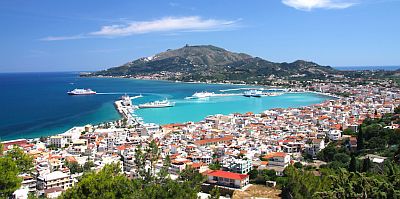
Despite the lack of many buildings over sixty years old thanks to the terrible quake, the island capital still manages to project a certain grandeur and preserve some sense of its former description by the Italians as “the Venice of the East”. It is dominated by the extremely long seafront that extends in angular fashion from the main port with its wide open quay to the squat pre-quake church of Agios Nikolaos tou Molou at the northern end. An almost unbroken string of cafes, restaurants, the odd hotel and a bunch of travel agencies, this is the town’s hub by day or night, with just a couple of commercial streets running parallel inland to rival it. The vast modern church of Agios Dionysios abuts a sizeable park towards the southern end. The delightful murals that cover the whole interior are well worth a peek, although you might find the collection of ecclesiastical garments and paraphernalia in the attached museum a little too, well, Orthodox, for the casual visitor.
Just inland from Agios Nikolaos tou Molou, the huge square of Agios Dionysios is dominated by the island’s unmissable Byzantine Museum, now known as the Museum of Zakynthos, at the rear end: as well as containing some important works of iconography by members of the Ionian School of Painting and fantastic murals from Agios Andreas church in Volimes, perhaps the most moving exhibit is the pre-quake model of the town. Towards the sea, an attractive statue of Eleftheria (the island’s very own Statue of Liberty) is inscribed with a stanza from Solomos’ Hymn to Liberty. The back end of the square leads onto a smaller platia named after Agios Markos, surrounded by cafes and restaurants and home to the pleasant Solomos Museum, dedicated to its namesake and other prominent Zakynthians.
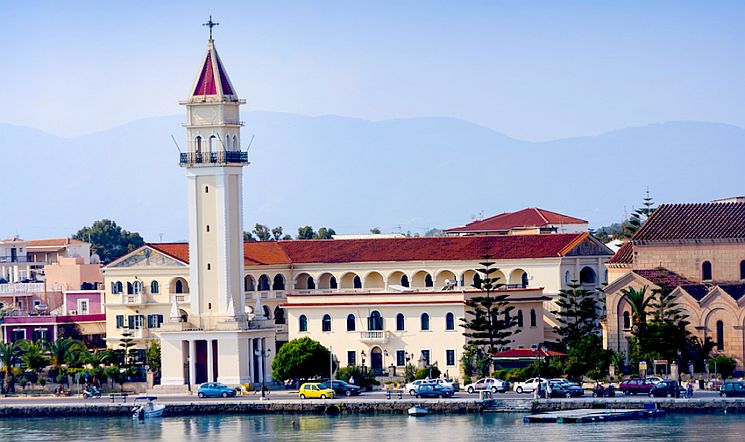
Other attractions include the quiet Repara district north of Agiou Markou Square but don’t let the signs to the town beach get your hopes up – it’s a pretty dull patch of stony sand. Towering two kilometres above the town is the suburb of Bohali, where you can visit the sturdy remains of the castle and enjoy brilliant views across the concrete jungle and bay to the outline of the Vassilikos Peninsula.
Unsurprisingly, Zakynthos Town offers the classiest range, if not the greatest number, of accommodations and restaurants on the island. It’s a good place to base yourself for touring the island and the only base if you’re relying on the skeletal bus service. the stand-out place to stay is the Palatino. The best restaurant in the vicinity of the capital is Malanos, tucked on a quiet cul-de-sac in the suburb of Kipi, off the Kalamaki road. The traditional food is superb and there is live acoustic music at weekends and nightly in peak season. For a posh and somewhat expensive fish blowout, head for Komis in the corner of the quay, which serves fresh seafood of all kinds, including some of the more unusual dishes such as sea urchin and razor clams. Best of the many restaurants that line the long seafront is Varkarola, which does good lunch deals and has nightly traditional kantades (folk ballads).
Touristic Zakynthos
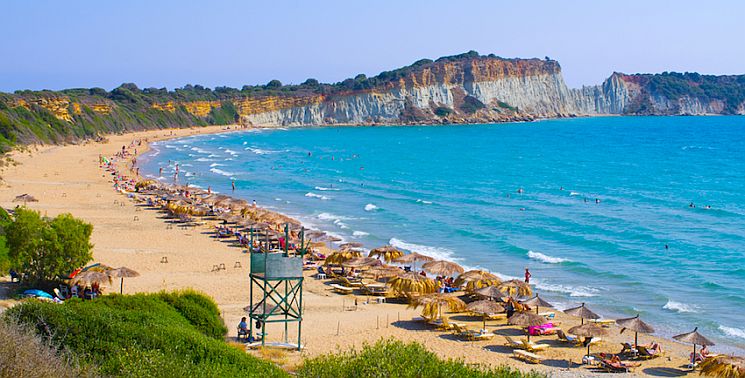
It would be unkind but not entirely untrue to say that over-the-top tourism spreads like a cancer in all coastal directions from Zakynthos Town, although the patient seems to have survived being killed by it, largely thanks to the intervention of geography. Heading south from the capital along the coast, the first resort you come to is unprepossessing Argassi, whose beach is a stringy affair and the whole place is better avoided, unless you want to frequent the massive clubs that have parked their Hollywood-style facades along the approach road.
From here the road undulates along the lower ridge of the Vassilikos Peninsula, with side roads that descend to a series of increasingly attractive strands, each offering some beachside hotels and restaurants. The peninsula has been described as Zakynthos’ answer to Florida and there is certainly something of the flaccid penis about its shape on the map. Almost all the beaches cluster on the east side and the best ones to stop for a dip are Porto Zorro, Ionio/Banana and Agios Nikolaos, whose largest hotel is smart enough to send a free bus round to scoop sunbathers up from Laganas and Kalamaki, especially for the unstricted watersports. The peninsula terminates at its southern tip in the delightful beach of Yerakas. However, this is one of the main loggerhead turtle breeding grounds (ecological issues are discussed below), so you may decide to content yourself with a visit to the pioneering Turtle Information Centre (www.earthseasky.org) whose interactive displays highlight the plight of the creature. Or have a bite at the pleasant garden taverna To Triodi. If you can’t resist a dip, follow any markers and instructions to the letter and under no circumstances stay on the beach after sunset.
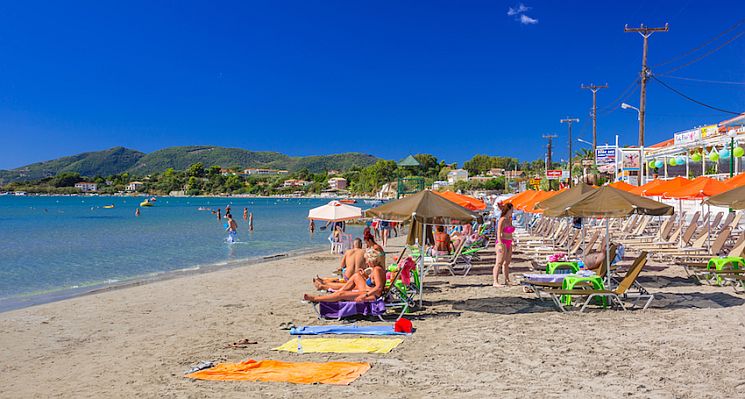
Heading southwest from the capital on the airport road brings you first to the turning for the relatively laid back resort of Kalamaki, the first settlement on the main stretch of Laganas Bay. The beach here is wide, sandy and surprisingly uncrowded, as most of the action lies almost a kilometre back in the centre. From the busy crossroads it’s a straight run of under 4pm into the heart of darkness, sorry, Laganas. Despite the general slump in tourism, this is still prime Club 18-30 territory, although I suspect there are precious few visitors who belong to the final ten years of that dozen. Gaggles of girls and bands of randy boys, almost exclusively Brits, flirtatiously egg each other on to greater excesses as the night wears on and pack into clubs such as Bad Boys, Zeros and Rescue but if you do venture here at night you’ll probably feel like being rescued without entering one of the dens. There is an uneasy tension with the locals, which occasionally spills over into violence, most notoriously when a young taxi driver took exception to having a laser pen directed at him in July 2011 and stabbed five English lads, one fatally. In the normal run of things, the place is not dangerous at all, of course, just unbelievably tacky. The restaurants are all of the plastic chips type, one noble exception being Sarakina, 2km inland, which provides a free shuttle to encourage young punters to sample its quality cuisine and nightly kantades.
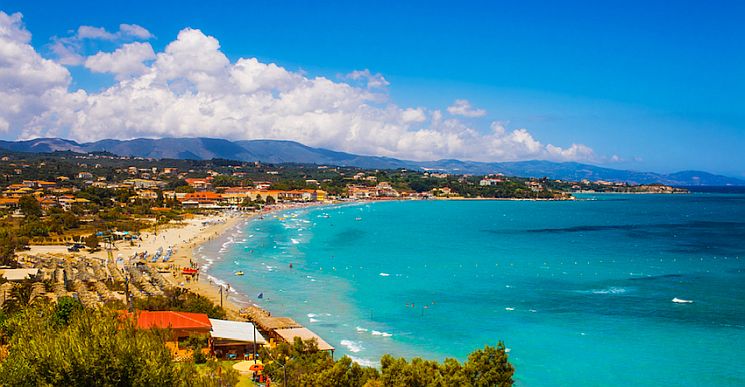
On the opposite, north side of Zakynthos Town, it is barely 4km to the conjoined resort of Tsilivi and Planos. If you can work out where one ends and the other ends, you deserve a prize. The truth is there’s nothing much to write home about in either of them but they do form the gateway to some pleasant little beaches just to the north, such as Pachys Ammos and Drossia. Although the most direct route to the region is via the main road north and inland from the capital, it is far nicer to follow the coastal road out of town and up round the promontory of Akrotiri, where the eponymous restaurant offers a spectacular view.
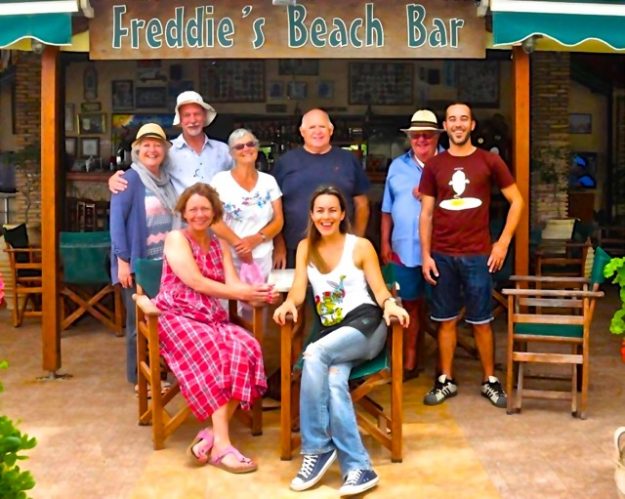
Also well worth mentioning is Freddie’s Beach Bar in Tsilivi which is considered by many to be the best beach bar on the island. It has a great location right on the beach, with sun beds and umbrellas and a nice variety of salads, mezedes, iced cold beer and mixed drinks. For those who are fans of Matt Barrett’s Greece Travel Guides and members of his Facebook group, this is the most likely place for you to run into fellow travelers, and Robert and Ritsa are terrific hosts.
The last and undoubtedly most pleasant of the major resorts on the island is around 12km north of town at Alykes, named after the extensive salt pans that back onto it. The beach is a little cramped but there is an easy-going air about the place and it is well placed for exploring the wilder parts of the north. It too has almost merged with its quieter southern sibling Alikarnas, from which it is separated by a kink in the coast and a small rivulet.
Unspoilt Zakynthos

Once you have negotiated your way through the dull arterial roads to the east and north of Zakynthos Town, lined with commercial properties and light industry, you find yourself in the gently undulating central plain of the island, a delightful tapestry of varying green hues. There is a mixture of the ubiquitous olive groves, vineyards, sunflower fields, vegetable patches and uncultivated clumps of deciduous trees such as plane and chestnut trees. Interspersed in this fertile landscape are some fine traditional villages, each boasting at least one church of varying antiquity. Of these, Tragaki and Yerakari stand out as worthwhile stops on the route north, while the workaday town of Katastari, directly inland from Alykes, gives you a good insight into island life away from tourism. Meanwhile, a few kilometers to the south, the tiny hamlet of Pigadaki is well worth a visit for the Vertzagio Museum, which displays agricultural and cultural paraphernalia, the diminutive chapel of Zoodochou Pigis with its unique well under the altar, and the excellent taverna Kaki Rahi.
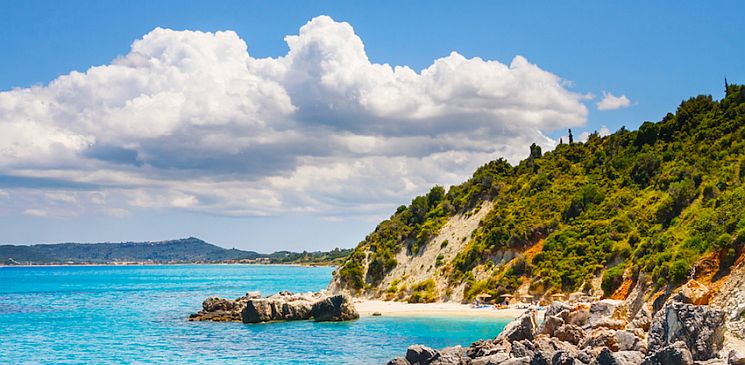
Pressing further north and back onto the coast, the road starts to undulate wildly as the coastline becomes steeper and care needs to be taken, especially if you are driving a two-wheeler and there is a strong wind blowing. One fine spot for a refreshing dip is Xygia beach, where underground currents of chilly water spurt from the sheer schist rock on one side into the warmer waters of the tiny cove. Another decent swim could be had at Makrys Yialos. Otherwise carry on and through Agios Nikolaos (which locals refer to as Skinari to differentiate it from the southern A.N.), only worth stopping at if you are taking the summer ferry connection to or from Pessada on Kefalonia. If your plan is to visit the Blue Caves, beware that there is a regular scam here whereby locals flag down unsuspecting tourists, claiming this is the last place you can get a boat to them from. Utter claptrap!
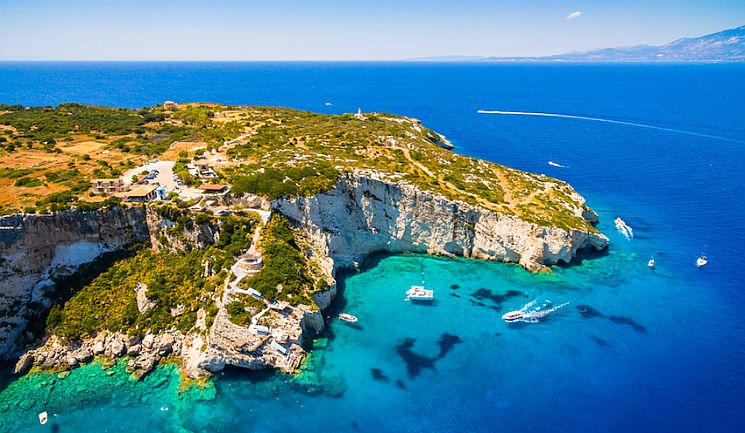
If you carry on through the increasingly barren landscape to the northern tip of the island at Cape Korithi, you can park up at the welcoming Faros taverna, whose delicious home-cooked food like kouneli stifado (rabbit stew) is comforting and filing. The three Potamitis brothers whose parents run the taverna also own one of the island’s most unique accommodations, the two converted windmills of Anemomilos, as well as some rooms. From beside these, you can actually walk down the steps to a swimming jetty that is only a couple of hundred metres south of the Blue Caves, well within the compass of a strong swimmer. You might get shouted at by the tourist boats though! Alternatively, the three bros run the cheapest boat trips to the caves and to Shipwreck Bay, from a jetty down past the lighthouse.
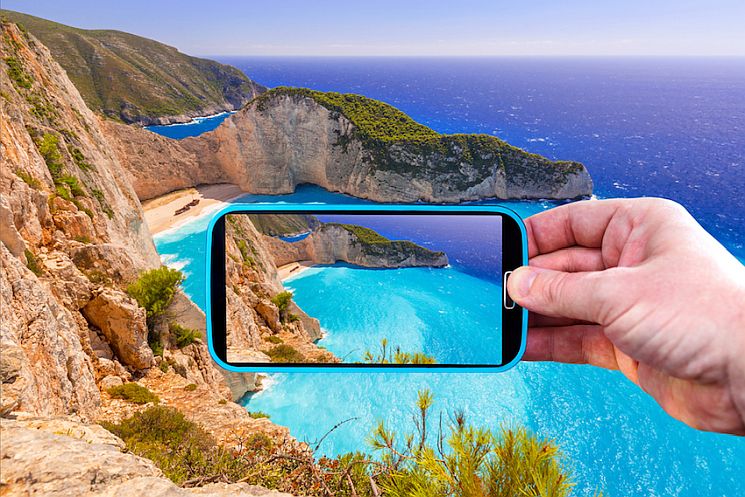
Heading west across the tip of the island, you soon reach the triple weaving centre of Volimes, divided into Kato V, Meso V and Ano V (Lower, Middle and Upper if you hadn’t guessed). The middle town especially is lined with emporia selling intricately designed rugs and the like – turtles are a favourite, unsurprisingly. Even if you have no intention of buying, the displays are highly photogenic. Further southwest, a split in the road offers you the choice between getting a bird’s eye view of Shipwreck Bay from an iron viewing platform that juts out from the cliff above. It’s not for those with vertigo but if you do have a head for heights you will be rewarded with exactly the same shot you see in all the brochures and guidebook covers, of the turquoise sea, biscuit-coloured cliffs and golden-white sand engulfing the rusting hulk of the ship that reputedly got ran aground here in the sixties by the coastguard, who erroneously believed it had contraband aboard. Some cynics even maintain the old crate was due for the knackers yard and was deliberately placed there by the local tourist authorities in the hope it would become the attraction it has done.
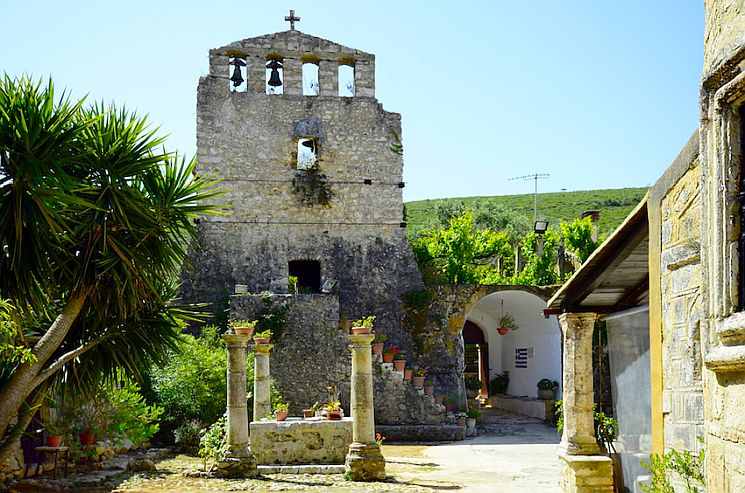
Further down the relentlessly rugged and mountainous western side of Zakynthos, a couple of monasteries and handful of villages stand out. The monasteries are those of Agios Georgios ton Kremnon and the more rewarding Anafonitria, which boasts some fifteenth-century frescoes, a few kilometres further south. Villages worth a peak include Orthonies, Agios Leon and, most notably Kiliomeno, home to the imposing church of Agios Nikolaos.
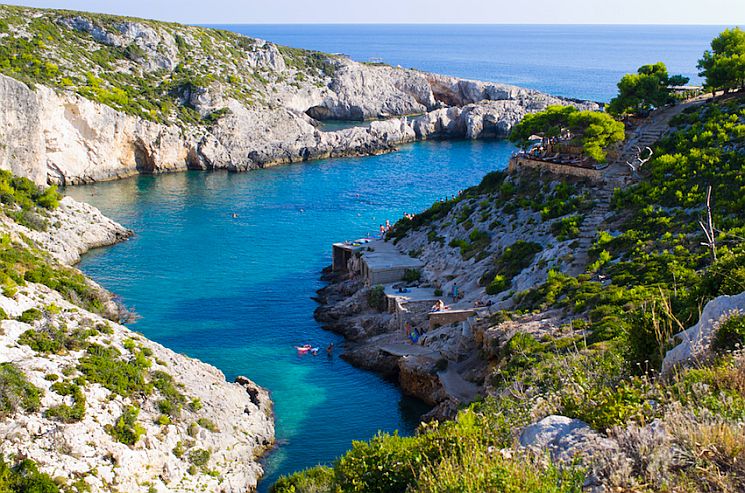
There is precious little access to sea level on the west coast, where you can only really reach Stenitis Bay, another launchpad for boat trips to Shipwreck Bay, or Porto Limnionas further south, a small pebbly cove whose eponymous taverna serves excellent if rather pricey fish. Most coach tours of the island stop at the village of Kambi, which huddles under an enormous cross to commemorate either nationalists killed in the civil war or fighters executed by the Nazis, depending on who you talk to. Either way, the place has become quite a tourist trap, especially at sunset, and the quality of its restaurants, in particular The Cross itself, has been called into question. A far better spot for sunset viewing is at the southern end of this coast, at the Keri lighthouse, most easily accessed from the main southwest road that serves Laganas Bay. The village of Keri itself is a peaceful and attractive place to enjoy an unhurried snack or drink.
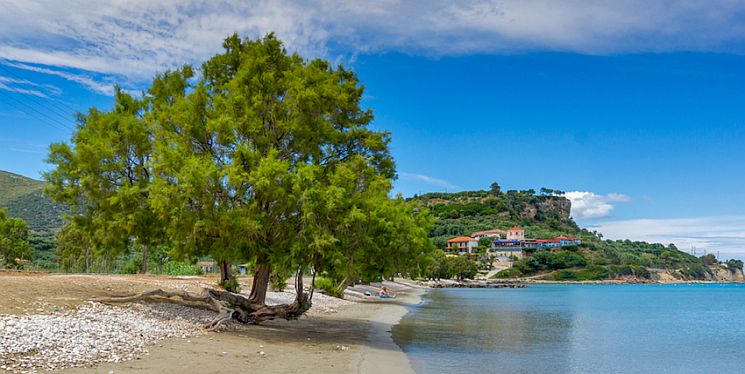
Finally, back on the coast around 5km from Keri village is my personal favorite hangout on the whole island, the sweet little beach of Limni Keriou, at the southwesternmost end of Laganas Bay. Set in its own gradually curving mini-bay, it has just enough choice of restaurants and cafes to provide some variety but it’s all very chilled. There are even two scuba diving operations, as it’s the closest beach to the interesting dive sites of the southwestern tip of the island. Good inexpensive accommodation is available too – look no further than the two places run by the extremely friendly Bratis family, the simple yet perfectly adequate Pansion Limni and the much smarter stone Pansion Tsi Ostrias.
Conservation Issues on Zakynthos
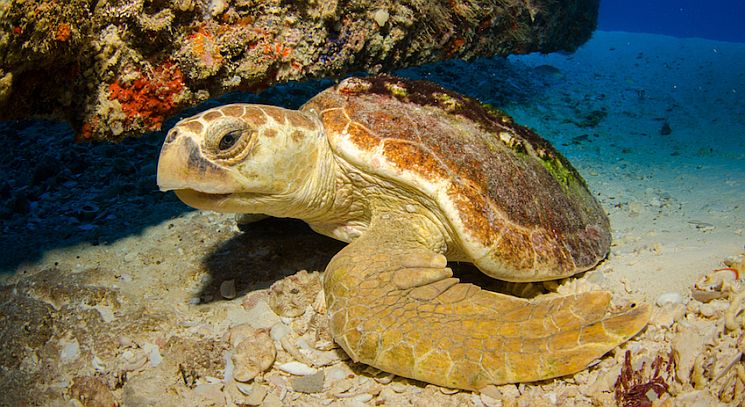
In 2000 the Zakynthos National Marine Park (ZNMP) was created to save the endangered Mediterranean loggerhead turtle known as Caretta caretta. The turtles have been laying their eggs in Laganas Bay since antiquity and the beaches of Zakynthos are their last stronghold. Despite good intentions the ZNMP received little funding from the ministry of the environment, public works and urban planning and battled with greedy locals who saw the protection of the turtles as an obstacle to developing the beaches for tourism. Although the beaches have been protected to some extent and restrictions imposed on construction and the speed of boats within the bay, these rules are all too often flaunted.
Obviously the people of Zakynthos consider bringing in the tourist euros more important than the plight of the turtles, understandable since we all have to make a living. However, this is short-sighted because those sea turtles are one of the main things that make Zakynthos an extraordinary island.
Rather than boycott Zakynthos altogether, perhaps the best policy is to follow the rules of the ZNMP yourself and largely steer clear of the main nesting sites of Laganas Bay. One look at Laganas itself and you’ll probably want to stay in another part of the island anyway.
You can also visit the Turtle Information Centre at Yerakas and register support for the protection of the turtles there or on their website at www.earthseasky.org. For information and to find out what you can do to help E-mail medasset@medasset.org or visit the website of Medasset: The Mediterranean Association to Save the Sea Turtles.
Getting To and Around Zakynthos
Zakynthos has several daily flights from Athens, a daily easyJet connection from London Gatwick from late March to October and plenty of charters from northern Europe, especially the UK, from May to October. The main ferry connection is from Kyllini on the coast of the Peloponnese, which has 5-7 services a day, according to the time of year, to Zakynthos Town. Note that you can take a KTEL Zakynthou bus from Athens or Patra direct to the island via the ferry but if you do that, get off at the quay because the bus station has recently moved to an inconvenient location way up at the back of town. (For bus schedules from Athens see www.athensguide.com/practicalinfo).
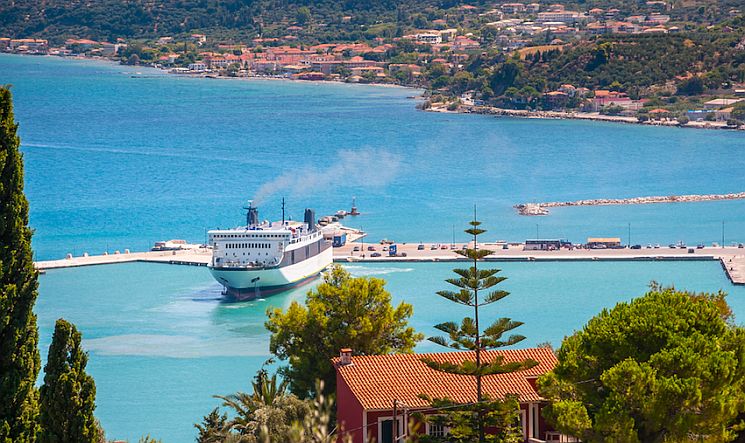
The only other ferry connection is the service (twice daily May to October) from Agios Nikolaos (Skinari) in the north of the island to Pessada on Kefalonia. Unfortunately, the isno public bus service to either port.
Since May 2018, there is finally a boat connection stopping at all the main Ionian Islands between Zakynthos and Corfu with High Speed Azimut Joy Cruises. It travels north to Corfu every Tuesday, Thursday and Saturday, having made the trip south on Monday, Wednesday and Friday. No sign of a dedicated website yet. You can find ferry schedules at Ferryhopper.com
Generally speaking, apart from a fairly frequent service to Kalamaki and Laganas, and decent ones to Tsilivi/Planos and Alykes, the Zakynthian bus network leaves much to be desired. The situation has been made yet more awkward by the relocation of the bus station, although you can pick up the Kalamaki/Laganas and rare Vassilikos peninsula buses at the bridge across the canal out past the port. It’s far better to rent a vehicle if you want to see much of the island and agencies abound in the capital and all the main resorts. A good way of spending a day and seeing the superb coastline is to take a round-the-island boat tour from Zakynthos Town. There are many to chose from so shop around but they all include stops at the Blue Caves and Shipwreck Bay. The main difference is in the size and comfort of the boat, so it’s smart to look at the vessels when they are docked in the evening. Note that only the smaller ones will be able to take you right into the Blue Caves.
 Nick Edwards first visited Greece on a school trip as a student of Classics in 1974 and fell in love with the country right away. He continued to visit while studying Classics and Modern Greek at Oxford University and subsequently worked in Athens as an EFL teacher for most of the 80s. Having had personal connections with the founders of the Rough Guides since the series’ inception, Nick started writing on Greece for them in 1992 and has since co-authored the Rough Guides to Greece, the Greek Islands, the Ionian Islands and Corfu, as well as titles on India and the USA. He has also covered Zakynthos for Berlitz and Insight Guides, various press articles and he writes the monthly blurb on the island for easyJet Traveller magazine. You can contact him by e-mail.
Nick Edwards first visited Greece on a school trip as a student of Classics in 1974 and fell in love with the country right away. He continued to visit while studying Classics and Modern Greek at Oxford University and subsequently worked in Athens as an EFL teacher for most of the 80s. Having had personal connections with the founders of the Rough Guides since the series’ inception, Nick started writing on Greece for them in 1992 and has since co-authored the Rough Guides to Greece, the Greek Islands, the Ionian Islands and Corfu, as well as titles on India and the USA. He has also covered Zakynthos for Berlitz and Insight Guides, various press articles and he writes the monthly blurb on the island for easyJet Traveller magazine. You can contact him by e-mail.



